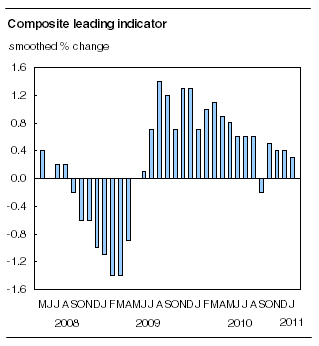Leading indicators
Archived Content
Information identified as archived is provided for reference, research or recordkeeping purposes. It is not subject to the Government of Canada Web Standards and has not been altered or updated since it was archived. Please "contact us" to request a format other than those available.
Related subjects
-
[an error occurred while processing this directive]
The composite leading index rose 0.3% in January, after increasing 0.4% in the previous two months. Growth again was led by the stock market and housing. In January, 4 of the 10 components fell, 1 less than in December.

Stock market prices trended up 2.6%, the fifth straight monthly advance. Energy stock prices led the gain, as mining paused after driving the rally late in 2010.
Household demand continued to expand. The housing index rose 1.3%, its third straight gain as strength in existing home sales outweighed a dip in housing starts. Furniture and appliance sales edged down 0.1%, but outlays for other durable goods increased 0.9%.
Manufacturing remained mixed. New orders fell 2.3%, their second straight decline. The ratio of shipments to inventories also fell for the second straight month, as the trend for shipments dropped for the first time in over a year. The average workweek at factories stopped declining. The leading indicator for the United States rose 0.7% in December, its largest advance in eight months.
Available on CANSIM: table 377-0003.
Definitions, data sources and methods: survey number 1601.
This release will be reprinted in the March 2011 issue of Canadian Economic Observer, Vol. 24, no. 3 (11-010-X, free). For more information on the economy, consult the Canadian Economic Observer.
For more information, or to enquire about the concepts, methods or data quality of this release, contact Francine Roy (613-951-3627) or Philip Cross (613-951-9162) or Cindy Bloskie (613-951-3634; ceo@statcan.gc.ca), Current Economic Analysis Group.
- Date modified:
